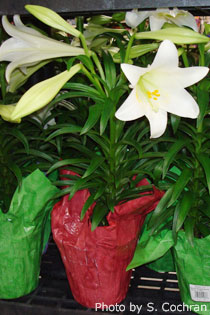 University of Nebraska–Lincoln
University of Nebraska–Lincoln
 University of Nebraska–Lincoln
University of Nebraska–Lincoln
NEBLINE Newsletter Article by Mary Jane Frogge, Extension Associate
We can thank Louis Houghton, a World War I soldier, for the popularity of the Bermuda lily, better known as the Easter lily, in this country. In 1919, he brought a suitcase full of hybrid lily bulbs to the southern coast of Oregon and gave them to family and friends to plant. The climate there was ideal for growing this lily, a native of the Ryukyu Islands of Japan, and by 1945, 1,200 west coast growers were producing bulbs for the commercial market. Up until that time, first Bermuda, and then Japan, dominated the U.S. export market.

Today, ten growers, most located along the California-Oregon border, in an area known as the "Easter Lily Capital of the World," produce 95 percent of all bulbs grown in the world for the potted Easter lily market. They produce almost 12 million bulbs, shipping them to commercial greenhouses in the U.S. and Canada. Despite a sales window of only two weeks, Easter lilies are the fourth largest crop in wholesale value in the U.S. potted plant market, according to the U.S. Department of Agriculture. Poinsettias, mums and azaleas, rank first, second and third.
The cultivar most commonly grown for U.S. markets is the "Nellie White." It is named for a lily grower's wife and has large, white, fragrant trumpet-shaped flowers. When buying a lily, look for a plant with flowers in various stages of bloom from buds to open or partially opened flowers. Foliage should be dense, rich green in color, and extend all the way down to the soil line. This is a good indication of a healthy root system. Look for a well-proportioned plant, one about two times as high as the pot. You also should check the flowers, foliage and buds for signs of insects and disease.
At home, keep your lily away from drafts and drying heat sources such as appliances or heating ducts. Bright, indirect light is best with daytime temperatures of 65 to 75° F. Water the plant only when the soil feels dry to the touch, but do not overwater. To prolong the life of the blossoms, remove the yellow anthers (pollen-bearing pods) found in the center of each flower.
Do not throw away you Easter lily after it is done blooming. You can save the bulb and plant it outdoors. Easter lilies can be replanted outside after the blooms are gone. Plant the Easter lily outdoors as soon as the ground can be worked. Select a sunny site with well-drained soil. Set the top of the bulb six-inches below the soil surface. Cut off the old flowers, but leave the stem and leaves. Do not cut back the stem until it dies down in the fall, then cut it off at the soil surface. After the soil surface freezes in late fall, mulch the soil and do not remove the mulch until new growth begins in the spring.
No comments:
Post a Comment